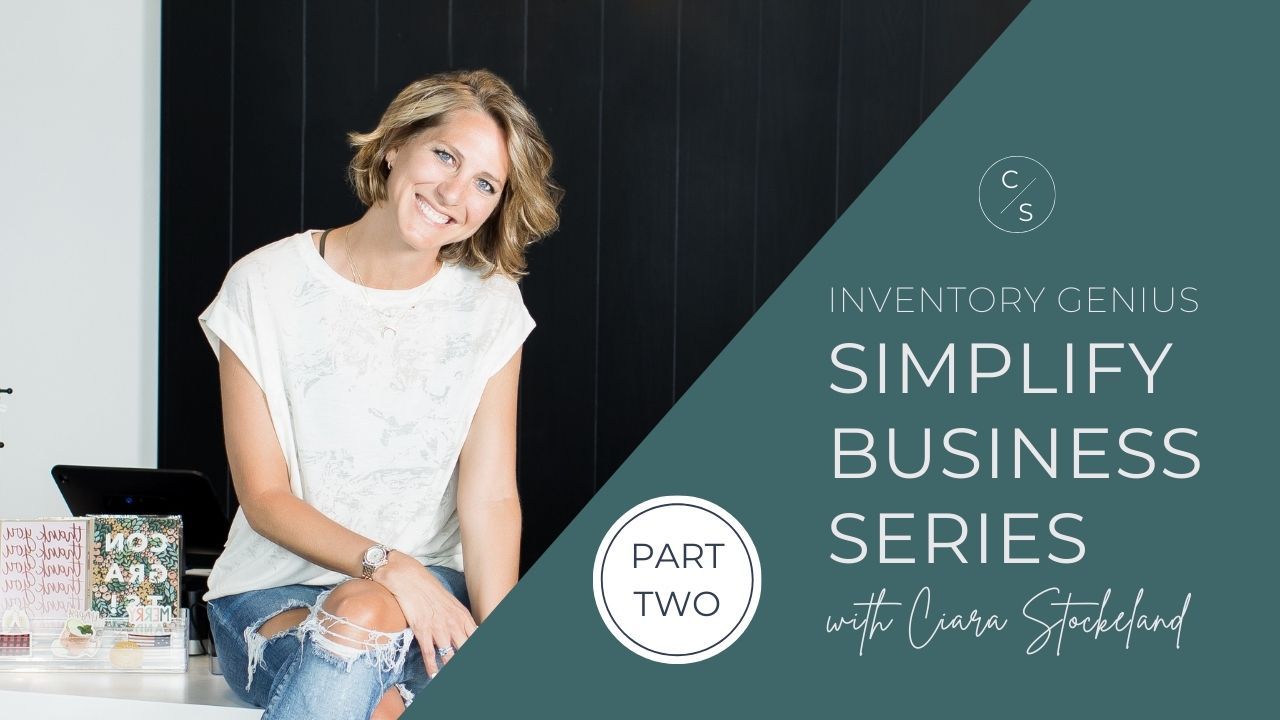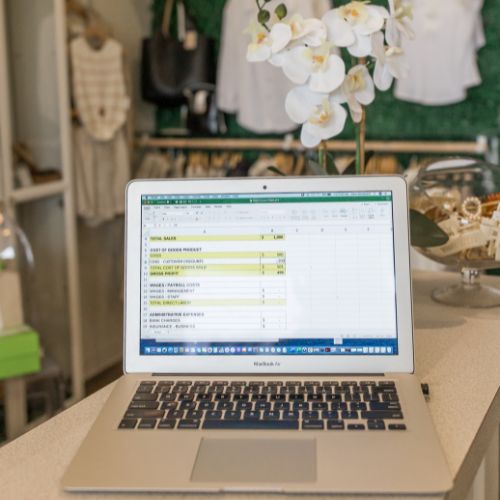Part Two: Simplify Business with the Inventory Genius Method
Jun 01, 2023
Welcome to Part Two of the Simplify Business Series. In this series, I'm taking a close look at those oftentimes-tricky questions that I know all inventory based business owners have. I'm breaking the questions down into simple steps. The bite-sized, actionable steps I'll offer will give you one task at a time to understand, complete and implement in your own business. And over time, you'll to begin to simplify the way you look at your business model. You'll be on your way to becoming an Inventory Genius and on the path toward profitability. You'll have a business strategy you can use.
Throughout the series, I will be using my Inventory Genius Method to explain the questions, the answers and the simplification process. In Part One of the Simplify Business Series, we covered the simple approach to minimizing your workload. It's such an important starting point, and once you've worked through it, you'll feel less overwhelmed and more in control of all the parts and pieces involved in your business. If you haven't already gone through those practices, you can find them here.

Now that you understand how you can simplify your workload, we're going to dive into all those nitty gritty pieces of your inventory based business. In Part Two of the Simplify Business Series, we'll cover sales goals, inventory, and budgeting. You'll learn to streamline each of these pieces. There's a simple approach to selling inventory fast and to finding profit in your business. We'll put it all together so that you have a complete grasp on how your business looks, what your numbers are telling you and where you need to shift, change and rework so that you can start moving and growing in the right direction, towards profitability. You'll be able to create more of a roadmap with profitability as your end goal. So...let's get going!
PART TWO: The SIMPLE APPROACH to Understanding Your Business
“Don’t be busy, be productive”
Day 8: The simple approach to breaking down a sales goal
“Step by step and the thing is done” -Charles Atlas
How do you define success? Maybe it is the ability to leave your 9-5 job and run your inventory based business full time. Maybe it is that your business produces enough revenue to support your kid’s college education or to provide an annual family vacation. Maybe for you, success is building a multi-store brand with a team of twenty under you. However you define success, breaking down your goal starts with monetizing that definition.
Maybe your goal is a $1,000, maybe it is $10,000 or maybe even $100,000..... whatever the monetary goal, being able to break it down starts with defining the number in the first place.
Once you know your ideal monetary goal, I want you to break it down first into periods of time. Break your overall goal down by month, then divide that goal by four as an average of how your goal is by week. Last, divide the weekly goal number by the number of days in your current work week. This will show you the key value for your daily monetary goal.
Once you've figured our your daily monetary goal, it's time to find your current average ticket amount. Divide your daily monetary goal by your current average ticket. This will tell you how many customers you need a day in order to realize your monetary goal.
From there I want you to create a daily plan of action to capture and sell to your needed customers!
Every sales goals needs to be broken down into the smallest metric so that it is bite sized and easily actionable!
Here's your coaching action step for today:
Define your monetary goal and then break it down. Here's a reminder of the steps:
- Define your overall sales goal.
- Divide your sales goal into periods of time (monthly, weekly, daily).
- Find your current average ticket number.
- Divide your daily goal by your average ticket
Here's an example:
- Overall sales goal: $1,000
- $1,000/5 days = $200/day
- Current average ticket: $45
- $200 daily monetary goal/$45 = 4.44 tickets a day to make monetary goal
Day 9: The simple approach to understanding your numbers
“Nothing happens without focus. Don’t try to do everything at once. Take it one step at a time” -Dave Ramsey
In retail business there are some simple numbers that you should understand, track and measure:
Gross sales: The total sales a business generates over a period of time.
Cost of Goods Sold: The cost of the inventory that was sold to generate the sales.
Gross Margin: The difference between the sales and the cost of the sales.
Expenses: The fixed and non-fixed costs of operating the business (This does NOT include inventory).
Net Profit/Loss: The difference of the gross margin less the expenses.

Take a look at each of these definitions and understand that each of these five numbers plays a key role in the profit or the loss of your business.
If your gross sales are down, you will not have enough to cover your expenses.
If your gross sales look great but you are running on too thin of a margin, there will be no room for profit.
If you have amazing sales, an awesome margin but spend money left and right on unnecessary (and unbudgeted) expenses like payroll or marketing, you could still see a net loss in your business.
On the other hand if your sales are in line with your goals, your margin dollars are high and your expenses remain in check, you will begin to see profit!
To better understand your numbers, start with one on which you will focus on for the next 30 days. Learn everything there is to know about how that number affects your business. Look to increase it (if it is sales or margin) and decrease or manage it well (if it is an expense).
Here's your coaching action step for today:
Choose one number you will focus on for the next 30 days. Write it down. Write down its definition. Take notes daily on what you are observing about that number in your business.
Day 10: The simple approach to streamlining your business
“The ability to simplify means to eliminate the unnecessary to that the necessary may speak” -Hans Hoffman
Do you have a brick-and-mortar store? An e-commerce website? Do you offer both pre-orders and ready-to-sell inventory? Do you sell socially, or do you meet your customers through pop-ups? As the landscape of “how to be an inventory based business” has shifted over the last several years, and even more so recently, I am going to assume that you are employing several (if not all!) of the above methods designed to help grow your business.
Can I just say it plainly? This is NOT a simple approach! You may think all of these selling methods are equal, and that you are simply selling the same items in a different manner, right? Wrong! In each of these modes of operation, you are serving different types of customers, conducting different hours of operations and applying a different customer service approach. You are running multiple businesses that simply sell the same products!
This is where it's critical to focus on the simple approach to streamlining your business.
Sit down and put a mark next to each one of the business models you use to sell your products. Next to that business model (herein referred to as “revenue stream”) write down the total sales for each method in the last 60 days.
Next, think about how many hours a week it takes you to make those sales in that revenue stream. Think about everything you do! For example, how many hours do you spend posting content (to your website, social media accounts, etc), setting up your inventory, working in the store, managing the employees, etc? Write down your time in hours next to each method of sale. Divide the total sales by the hours spent to generate those sales. This is how you can identify the revenue streams that are most effective.
Take a close look at which revenue streams are really generating the most for you. Lean into what is working best - most revenue per hours spent. Lean into that and do more of it! Don't be afraid to cut out the revenue streams that are simply not worth your effort and time!
You only have so much time to spend in each work week, so freeing up more time to do what works - and removing what doesn't - will help your business flourish. It will put you and and your business on the path to profitability.
Here's your coaching action step for today:
Think about what area of your business you want to focus on and work through the following:
→ My current revenue streams:
→ What I love doing:
→ What I want to eliminate:
Day 11: The simple approach to budgeting
“By failing to prepare, you are preparing to fail.” -Benjamin Franklin
We think of budgeting as a restrictive process that tells us what we can and cannot spend.
And while this is an important part of the budgeting process, budgeting also helps us identify our priorities and encourages us to turn our goals into action plans.

The simple approach to budgeting is as follows:
To better understand your numbers, create a simple budget using the numbers identified in step nine. Gather all of your current expenses, and be honest about them. Add them up to see how much you spend in a month's time, including payroll.
Next, fill in the gross sales blank with your current monthly sales goal.
From there, fill in your COGS based on your current margin. Fill in the gross margin blank with the difference between your gross sales and your cost of goods sold.
This number, the gross margin, is what you have left to use to pay your bills (or your expenses).
After subtracting your expenses from your gross margin, you will be left with your next profit or loss.
This tells the true story of your business!
Here's your coaching action step for today:
Add up your expenses. Write them all down. Determine your monthly break even point. Decide what you should cut/keep/increase!
→ My expenses:
→ My break even:
→ What I want to eliminate:
Day 12: The simple approach to understanding your inventory
The simple approach to understanding your inventory begins with the concept that "buying" is more than exchanging dollars for inventory. Buying is, in fact, the entire process - from the moment you find something you want to sell until the moment that item goes home with a customer.
Inventory is the lifeblood of a retail business. Your inventory, and the management of it, can make or break any retail business.
The first step in the process of better understanding your inventory is to use an open-to-buy (OTB) budget when buying inventory. Using an OTB will ensure that you are purchasing the inventory you actually need for your inventory based business based on what is currently selling and the inventory you need to keep in stock to meet your sales goals.
The second step is to make sure you are properly receiving inventory, meaning that you are entering both the retail price and the cost of each item into your POS system.
Track and measure your inventory monthly for simple inventory control.
Here's your coaching action step for today:
Using the Open To Buy formula, determine your monthly inventory budget. Write down what you observe when you look at what you have been spending and what you should be spending.
Day 13: The simple approach to selling inventory fast
“Inventory is cash in boxes and cash on hangers.” -Ciara Stockeland
While new inventory can be exciting to receive, old inventory can cause major headaches. When you have old inventory, it benefits your business to move it - FAST!
Two of the simplest ways to move inventory quickly are 1) to lean on social platforms to create a live social selling event or 2) to host a local in-person pop up.

Organize and prepare your live social event. Plan to keep it within an hour, and remember you are virtually welcoming customers into your "store", so do your best to create a personal experience as you would with any in-person customer.
Before your pop up event, make sure to leave enough time to talk to your community about the exciting upcoming event, and then to show up and serve them well.
Here's your coaching action step for today:
Take stock of inventory that you need to sell quickly. Plan out your next live social selling event or pop up. Create a plan of how much inventory you will sell, the prices you will sell it for and ultimately you overall sales goal. Write down a date, commit and make it happen!
Day 14: The simple approach to finding profit in your business
Do you feel like you're forever making sales, but forever low on cash? Maybe you can't help but wonder where all the money is going?
If you feel this way - like you continue to make sales, you are achieving your goals, but you don't see the profits - here are three areas to review:
→ Margin
→ Discounts
→ Shipping
Area 1: Your gross margin.
What is your current overall margin? Are you marking up your inventory enough to create a margin that can cover your expenses?
Area 2: Your discounts.
Perhaps you start with a healthy overall margin, but you have so many loyalty programs, discounts and giveaways that they eat into the profit you deserve!
Area 3: Shipping.
This is another area that is often overlooked but can directly affect your overall profit. Do you offer free shipping to your customers, and, if so, is there benefit in your free shipping threshold?
Take a good look at these three areas and see which area might be limiting your potential profit.
Here's your coaching action step for today:
Take a deep dive into your current numbers. Where are you bleeding profit opportunity? What is your plan to stop the profit bleed and simply start building profit instead?
Congratulations! You're done with Part Two of the Simplify Business Series! Part three's coming soon - get ready to continue simplifying your business and working toward profitability.
If you'd rather breeze ahead of these posts and dive into the Inventory Genius process all at once, I invite you to get started with the Quickstart to Inventory Genius.
The Quickstart is my keystone coaching roadmap. Three modules will quickly layout five things to focus on in your inventory based business. You can implement these five strategies right away in order to drive immediate profit. And with the Quickstart, I GUARANTEE that you'll double your investment through either making, saving, or finding that amount in PROFIT. The Quickstart really is the perfect way to get your inventory based business on the right track.
